The Eastern Counties Railway (ECR) was an English railway company incorporated in 1836 intended to link London with Ipswich via Colchester, and then extend to Norwich and Yarmouth.

The Wherry Lines are railway branch lines in the East of England, linking Norwich with Great Yarmouth and Lowestoft. There are 14 stations on the lines, including the three termini. They form part of Network Rail Strategic Route 7, SRS 07.11 and are classified as a rural line.

Berney Arms railway station is a stop on the Wherry Lines in the East of England, serving the settlement of Berney Arms on the Halvergate Marshes in Norfolk. It is located 15 miles 71 chains (25.6 km) east of Norwich and is the only station on a short stretch of single line between Reedham and Great Yarmouth. The station is managed by Greater Anglia, which also operates all trains serving it.

Reedham railway station is a stop on the Wherry Lines in the East of England, serving the village of Reedham, Norfolk. It is 12 miles 13 chains (19.6 km) down the line from Norwich; it is situated between Cantley to the west and, to the east, Berney Arms on the branch to Great Yarmouth or Haddiscoe on the branch to Lowestoft. It is commonly suffixed as Reedham (Norfolk) in order to distinguish it from the station of the same name in south London. Its three-letter station code is REE.

Great Yarmouth railway station is one of two eastern termini of the Wherry Lines in the East of England, serving the seaside town of Great Yarmouth, Norfolk. The other terminus at the eastern end of the lines is Lowestoft and the western terminus, to which all trains run, is Norwich.

Norwich railway station is the northern terminus of the Great Eastern Main Line in the East of England, serving the cathedral city of Norwich, Norfolk. It is 114 miles 77 chains (185.0 km) down the main line from London Liverpool Street, the western terminus.

Cantley railway station is a stop on the Wherry Lines in the East of England, serving the village of Cantley, Norfolk. It is 10 miles (16 km) down the line from Norwich on the routes to Lowestoft and Great Yarmouth; it is situated between Buckenham and Reedham. Its three-letter station code is CNY.
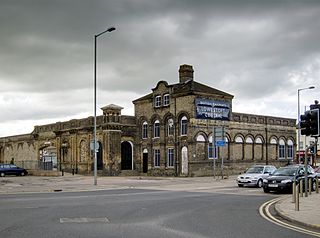
Lowestoft railway station serves the town of Lowestoft, Suffolk. It is the eastern terminus of the East Suffolk Line from Ipswich and is one of two eastern termini of the Wherry Lines from Norwich. Lowestoft is 23 miles 41 chains (37.8 km) down the line from Norwich and 48 miles 75 chains (78.8 km) measured from Ipswich; it is the easternmost station on the National Rail network in the United Kingdom.

The Breckland line is a secondary railway line in the east of England that links Cambridge in the west to Norwich in the east. The line runs through three counties: Cambridgeshire, Suffolk and Norfolk. It takes its name from the Breckland region of Norfolk and passes through Thetford Forest.
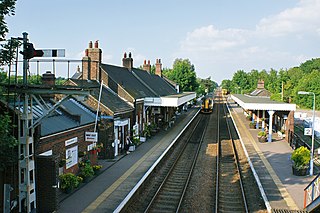
Wymondham railway station is a stop on the Breckland Line in the East of England, serving the market town of Wymondham, Norfolk. The line runs between Cambridge in the west and Norwich in the east. It is situated between Spooner Row and Norwich, 113 miles 72 chains (183.3 km) from London Liverpool Street via Ely.
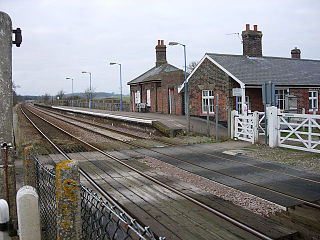
Buckenham railway station is a stop on the Wherry Lines, which serves the village of Buckenham in Norfolk, England. It is 7 miles 62 chains (12.5 km) down the line from Norwich on the routes to Lowestoft and Great Yarmouth; it is situated between Brundall and Cantley. Its three-letter station code is BUC.
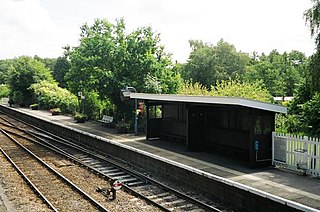
Brundall railway station is on the Wherry Lines in the east of England, serving the village of Brundall, Norfolk. It is 5 miles 60 chains (9.3 km) down the line from Norwich on the route to Great Yarmouth and Lowestoft. Its three-letter station code is BDA.

Thetford railway station is on the Breckland line in the east of England, serving the market town of Thetford, Norfolk. The line runs between Cambridge in the west and Norwich in the east.

Attleborough railway station is on the Breckland line in the east of England, serving the market town of Attleborough, Norfolk. The line runs between Cambridge in the west and Norwich in the east. Attleborough is situated between Eccles Road and Spooner Row, 108 miles 19 chains (174.2 km) from London Liverpool Street via Ely.
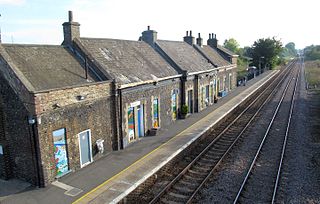
Brandon railway station is on the Breckland Line in the East of England, serving the town of Brandon, Suffolk, although the station is actually situated across the county boundary in Norfolk. The line runs between Cambridge in the west and Norwich in the east.
The Newmarket and Chesterford Railway Company was an early railway company that built the first rail connection to Newmarket. Although only around 15 miles (24 km) long the line ran through three counties, the termini being in Essex and Suffolk (Newmarket) and all intermediate stations being in Cambridgeshire.

Norwich Victoria was a railway station in Norwich, Norfolk, England, and the former terminus of the Great Eastern Main Line. It was at one time one of three stations located in Norwich, the others being Norwich City and Norwich Thorpe. City station closed in 1969, but Thorpe station, now known simply as Norwich, remains in use.
The Norwich & Brandon Railway (N&BR) was the second railway in Norfolk, England, after the Yarmouth & Norwich Railway (Y&NR). Its Act of Parliament on 10 May 1844 authorised it to build a line between Norwich and the small town of Brandon, actually just across the border in Suffolk.

The Norfolk Railway was an early railway company that controlled a network of 94 miles around Norwich, England. It was formed in 1845 by the amalgamation of the Yarmouth and Norwich Railway opened in 1844, and the Norwich and Brandon Railway, not yet opened. These lines were built out of frustration that the Eastern Counties Railway line that was expected to connect Norwich to London failed to be completed. The Norfolk Railway also leased the Lowestoft Railway and Harbour Company, and built a branch to Dereham and Fakenham, opened in 1846 and 1849 respectively.
The East Suffolk line is a railway in East Anglia with a long history.

















